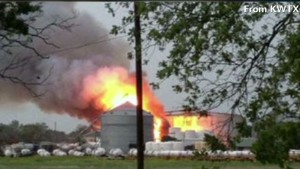Another tragedy in the USA.
So far more than 100 persons injured.
Replies sorted oldest to newest
(CNN) -- An explosion ripped through a fertilizer plant Wednesday night in the town of West, Texas, sending a massive fireball into the sky and causing dozens of injuries, officials said.
A number of nearby residents were being evacuated because of the possibility of another explosion, officials said.
A hospital in nearby Waco, Texas, has been told to anticipate 100 injured people coming in from the fertilizer plant area, an official at the medical facility said.
Glenn Robinson, CEO of Hillcrest Hospital, said a field triage station was being set up on a football field near the plant some 18 miles north of Waco after the Wednesday night explosion.
 <cite class="expCaption">Resident: Like a bomb in the backyard</cite>
<cite class="expCaption">Resident: Like a bomb in the backyard</cite>"We have had a steady flow of patients coming in by ambulance as well as by private vehicles," Robinson told CNN's Anderson Cooper.
More than 40 patients were received as of 10 p.m. (11 p.m. ET), Robinson said, suffering from "blast injuries, orthopedic injuries (and) a lot of lacerations. While some of the injuries are minor, others are "quite serious," he said.
Blast kills nearly 70, injures 100s in Texas, authorities say

A smoke cloud rises from an explosion at a fertilizer plant near Waco, Texas, April 18, 2013.
West Emergency Medical Services (EMS) director George Smith said that some 60 to 70 people died and hundreds of others were injured in the explosion on Wednesday at West Fertilizer plant in the city of West, located about 32 kilometers (20 miles) north of Waco.
An official at a hospital in Waco said that they were told to anticipate 100 injured people coming from the explosion area.
According to Waco Assistant Fire Chief Don Yeager, the fertilizer facility had an anhydrous ammonia explosion. However, the cause still remains unknown.
There have also been reports of several buildings to be on fire, including a middle school.
The blast was felt as far as 24 kilometers (15 miles) away.
More than 2,000 customers were without power in the area, according to the local power utility, Oncor Electric.
On April 15, the United States experienced another explosion, which hit the Boston marathon, killing three and injuring more than 150 others.
One day later, authorities intercepted letters poisoned with the deadly substance, ricin, which were intended to reach US President Barack Obama and Mississippi Republican Senator Roger Wicker.
There is one tank that is still standing, if that explode it can be more death.
I am surprised they had a fertilizer plant so close by. As any older Guyanese would know who played with the carbide we put in an ovaltine tin and spit on it before shaking it and putting a match to the hole in the tine, water and certain chemicals don't mix. Calcium is a highly explosive chemical when you douse it with water.
I am surprised they had a fertilizer plant so close by. As any older Guyanese would know who played with the carbide we put in an ovaltine tin and spit on it before shaking it and putting a match to the hole in the tine, water and certain chemicals don't mix. Calcium is a highly explosive chemical when you douse it with water.
You were not a science student.
In any event the culprit here is anhydrous ammonia stored in pressurized tanks.
Contrary to magnesium placed directly above calcium in the periodic chart, elementary calcium reacts with water at room temperature, according to the following reaction mechanism:
Ca (s) + 2H2O (g) -> Ca(OH)2 (aq) + H2 (g)
This reaction forms calcium hydroxide that dissolves in water as a soda, and hydrogen gas.
Other important calcium reaction mechanisms are erosion reactions. These usually occur when carbon dioxide is present. Under normal conditions calcium carbonate is water insoluble. When carbon dioxide is present carbonic acid is formed, affecting calcium compounds.
The reaction mechanism for carbon weathering is:
H2O + CO2 -> H2CO3 and CaCO3 + H2CO3 -> Ca(HCO3)2
And the total reaction mechanism:
CaCO3 (s) + CO2 (g) + 2H2O (l) -> Ca2+ (aq) + 2 HCO3- (aq)
The product is calcium hydrogen carbonate.
Calcium often positively affects soil quality and various compounds are applied as a fertilizer. For example, CaCl2- or Ca(NO)3solutions are applied in horticulture. Calcium oxide is a dehydrating molluscicide.
Contrary to magnesium placed directly above calcium in the periodic chart, elementary calcium reacts with water at room temperature, according to the following reaction mechanism:
Ca (s) + 2H2O (g) -> Ca(OH)2 (aq) + H2 (g)
This reaction forms calcium hydroxide that dissolves in water as a soda, and hydrogen gas.
Other important calcium reaction mechanisms are erosion reactions. These usually occur when carbon dioxide is present. Under normal conditions calcium carbonate is water insoluble. When carbon dioxide is present carbonic acid is formed, affecting calcium compounds.
The reaction mechanism for carbon weathering is:
H2O + CO2 -> H2CO3 and CaCO3 + H2CO3 -> Ca(HCO3)2
And the total reaction mechanism:
CaCO3 (s) + CO2 (g) + 2H2O (l) -> Ca2+ (aq) + 2 HCO3- (aq)
The product is calcium hydrogen carbonate.
Calcium often positively affects soil quality and various compounds are applied as a fertilizer. For example, CaCl2- or Ca(NO)3solutions are applied in horticulture. Calcium oxide is a dehydrating molluscicide.
I know the activity series. It is what we learn in form one chemistry. Calcium in water does no explode or we would all be popping left and right since our bones are calcium and it is steeped in water.
So, we can depend on Chief to bring us all the blown up news on GNI. The blown up news man of the months. Is that right, Chief? ![]()
Access to this requires a premium membership.